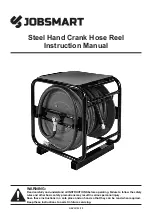
11
3. The rear fence should be advanced to contact the
work as shown in Figure 11. The rear fence will
then be in line with the cutting circle.
Shaping with Collars and Starting Pin
Follow these rules when shaping with collars and
starting pin for safest operation and best results:
1. Collars must be smooth and free from all gum or
other substances.
2. The edge of the work must be smooth. Any
irregularity in the surface which rides against the
collar will be duplicated on the shaped surface.
3. A portion of the work's edge must remain
untouched by the cutter so that the collar will have
sufficient bearing surface. See Figure 12 for an
example of insufficient bearing surface. Figure 13
illustrates sufficient bearing surface.
4. The work must be fairly heavy in proportion to the
cut being made. See Figure 14. Under no
circumstances should a small workpiece be
shaped against the collars as shown in Figure 15.
Collar Positioning
Collars may be positioned above, below, or between
two cutters:
1. When using the collar below the cutter, Figure 16,
the progress of the cut can be observed at all
times. A disadvantage of this method is any
accidental lifting of the work will gouge the wood
and ruin the workpiece.
2. Using the collar above the cutter, Figure 17, offers
the advantage of the cut not being affected by
slight variations in the stock's thickness.
However, the cut is not visible during the
operation. Another advantage is accidental lifting
of the work piece will not gouge the work piece.
Simply correct the mistake by repeating the
operation.
Figure 11
Figure 12
Figure 13
Figure 14
Figure 15
Figure 16
Figure 17
Summary of Contents for JWS-22CS
Page 15: ...15 Table and Fence Breakdown ...
Page 16: ...16 Fence Breakdown ...
Page 20: ...20 Electrical Schematic ...
Page 21: ...21 Electrical Schematic for the Forward Reverse Switch ...
Page 22: ...22 Notes ...
Page 23: ...23 Notes ...
Page 24: ...24 WMH TOOL GROUP INC 2420 Vantage Drive Elgin IL 60124 Ph 800 274 6848 www wmhtoolgroup com ...










































